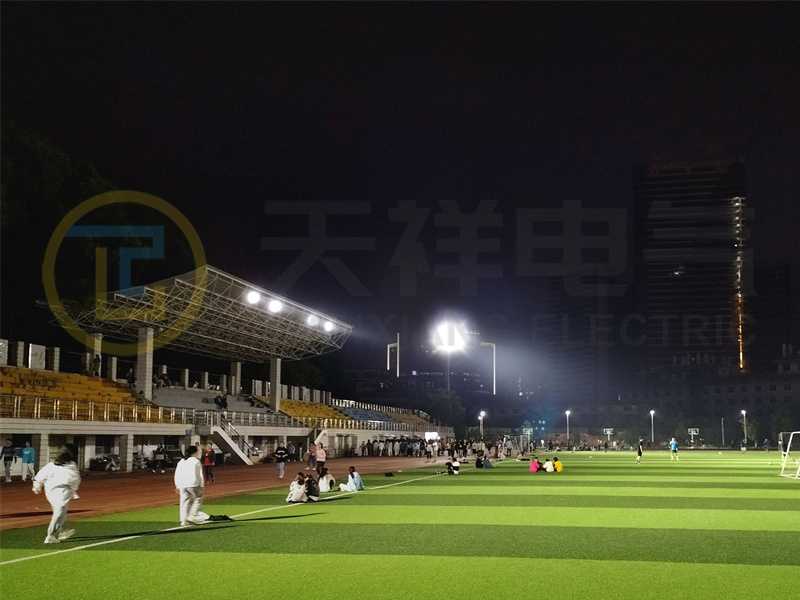When it comes to outdoor stadium lighting, the right choice of fixtures is critical to ensuring optimal visibility, safety and performance. Whether you’re lighting a football field, baseball field, or track and field facility, the quality of lighting can significantly impact the experience for athletes and spectators. In this article, we’ll look at the key factors to consider when choosing outdoor stadium lighting fixtures.
1. Understand lighting requirements
Before getting into the details of fixture selection, it’s necessary to understand the lighting requirements for your specific sport. Different sports have different lighting needs based on the level of competition, venue size and competition time. For example, a professional football stadium may require a higher lux level (measured in lumens per square meter) than a local community baseball field.
Primary lux levels by sport:
- Football: 500-1000 lux for amateur games; 1500-2000 lux for professional games.
- Baseball: 300-500 lux for amateurs; 1000-1500 lux for professionals.
- Athletics: 300-500 lux during training; 1000-1500 lux during competition.
Understanding these requirements will help you determine the type and number of fixtures needed for your stadium.
2. Choose the right light type
When it comes to outdoor stadium lighting, there are several types of fixtures to consider:
a. LED light
LED lights are becoming increasingly popular in outdoor sports lighting due to their high energy efficiency, long life and low maintenance costs. They provide bright, even light and can be easily dimmed or adjusted to meet specific lighting needs. Additionally, LED technology has advanced to the point where it can produce high-quality light that minimizes glare, which is critical for both athletes and spectators.
b. Metal halide lamp
Metal halide lamps have always been the traditional choice for sports lighting. They have excellent color rendering and high lumen output, making them suitable for use over large areas. However, they consume more energy than LEDs and have a shorter lifespan, which can lead to higher operating costs over time.
c. High pressure sodium (HPS) lamp
HPS lamps are another option, known for their efficiency and long life. However, the yellowish light they emit may not be suitable for all sports, especially those that require accurate color representation.
3. Consider the beam angle
The beam angle of the luminaire is another key factor in outdoor stadium lighting. A narrow beam angle can focus light on a specific area, while a wider beam angle can illuminate a larger space. For sports fields, a combination of the two may be necessary to ensure that all areas are adequately lit without creating dark spots.
Beam angle selection tips:
- Narrow Beam Angle: Ideal for high pole lighting where focused light is required.
- Wide beam angle: Suitable for general area lighting to cover a larger space.
4. Evaluate color temperature
Color temperature is measured in Kelvin (K) and affects how light appears in the environment. For outdoor sports stadium lighting, it is generally recommended that the color temperature is between 4000K and 6000K. This range provides bright white light that enhances visibility and reduces eye fatigue for athletes and spectators.
Benefits of higher color temperature:
- Improved visibility and clarity.
- Enhanced color rendering for better performance.
- Reduces glare, which is crucial for night racing.
5. Evaluate durability and weather resistance
Outdoor stadium lighting must withstand a variety of weather conditions, including rain, snow and extreme temperatures. Therefore, it is crucial to choose fixtures that are durable and weather-resistant. Look for fixtures with a high ingress protection (IP) rating, which indicates their ability to resist dust and moisture.
Recommended IP Level:
- IP65: dust-proof and water-jet resistant.
- IP67: Dustproof and withstands immersion in water.
6. Energy efficiency and sustainability
As energy costs rise and environmental concerns become more severe, energy efficiency has become an important factor in selecting lighting fixtures for outdoor sports stadiums. LED lights are the most energy-efficient option, using 75% less energy than traditional lighting solutions. Additionally, consider fixtures that are compatible with smart lighting controls, allowing automatic dimming and scheduling to further reduce energy consumption.
7. Installation and maintenance
Finally, consider the installation and maintenance aspects of the lighting system you choose. Some lights may require specialized installation, while others can be installed easily. Also, consider long-term maintenance needs, including bulb replacement and cleaning. Choosing LED fixtures can result in less frequent maintenance because they last longer.
In conclusion
Choosing the right fixtures for outdoor sports stadium lighting requires careful consideration of a variety of factors, including lighting requirements, fixture type, beam angle, color temperature, durability, energy efficiency and maintenance. By taking the time to evaluate these elements, you can create a well-lit environment that enhances the experience for athletes and spectators, ensuring every game is played under optimal conditions. Whether you are upgrading an existing facility or designing a new one, the right lighting solution will make all the difference.
Post time: Sep-26-2024





